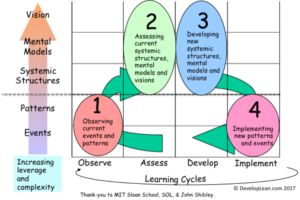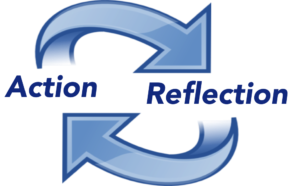A Framework for the Systematic Improvement of Product Development.

I tell my friends in manufacturing they have it easy. Manufacturing is easy to improve because you can physically see the work. You can follow the flow of material from incoming receiving to shipping. You can watch a part come into a machine or into an assembly station and see the physical transformation of the part. You can walk into a factory and know immediately if ‘the line is down’, count the rate it’s running (Takt time), and you can see the problems. That is not the case in product development. I can’t stand at my office door or peak over my cubical wall and see if ‘product development is down’. Most organizations don’t even think about their product development rate (cadence). I can’t see the flow of work and I can’t see the problems. I can see the results of the work, the output of my product development system, and I experience the consequences from the problems caused by a system I can’t see every day. So how do I improve a system I can’t see?
History has shown the only way to improve is by learning and doing. You can’t improve if all you do is learn and never apply what you learn. You won’t improve if you work hard but never learn. In order to improve you must ‘Act and Reflect’.

So let’s put this notion of Action and Reflection in the context of a product development system. The diagram at the top depicts a framework for learning and action to improve a system you cannot see. (The Learning / Action Matrix™)
Along the vertical axis are stages increasing in depth of reasoning. Progressing up the axis, each stage increases in leverage but reduces in tangibility. Your greatest leverage for change is in your vision because it has the broadest reach, yet vision is the least tangible. The least leverage is in individual events that occur in the product development process, although they are the most tangible. Unfortunately most organizations spend their efforts on tangible, low leverage events in fits of ‘firefighting’ just to get product out the door and never progress up the axis where the real leverage for improvement exists.
How do you instill a vision and improve product development?
The Learning / Action Matrix™ above identifies the four steps necessary. Learning begins in the first step by observing the events and patterns that occur and testing your observations against your vision. How do the actual events and patterns you observe compare to the vision you have? What are the gaps? Gain clear alignment and document the gaps against your vision, then move on to step two.
The hard work of leadership and improvement begins in step two by assessing the systemic structures of your processes that caused the events and patterns you observe. For example, were resources shifted from later projects to help resolve problems with projects closer to production creating more issues on the projects they were pulled from? Why? What caused the need? A strong leadership team will challenge themselves in assessing their individual mental models of what occurred and why. It is critical this happen without pointing fingers or blame. Build a collective mental model of your development system and test its behavior against your vision.
Step three entails identifying the changes in behavior that the leadership will undertake based on alignment on mental models to support the shared vision. As you assess the connection between behaviors and results, develop the changes to the system and actions you will take. Use the scientific method to improve your next learning cycle by documenting the improvements you believe your changes will deliver.
Finally, step four – take action! Go implement what you identified. Change behaviors based on the structured, deliberate rationale you agreed. Hold yourselves accountable but recognize you have not achieved perfection; so get ready to do it again.
Setting aside one day per month or per quarter for your team to reflect is a good way to start. If you want to kick-start the process, borrow liberally from proven Lean Product Development methods as part of step 3. Do not implement blindly. (Blind followership does not allow for learning) Challenge the changes against your mental models of how your product development works. That’s how you learn. There’s just no way to circumvent these cycles if you want to learn and improve.
Related Article: Why do organizations expect the result Lean Product Development delivers but are unwilling to do the work?
https://www.linkedin.com/pulse/reflecting-dr-allen-ward-why-do-organizations-expect-oosterwal?published=t
If you’d like to learn more about the Learning / Action matrix™ and its application, the book, The Lean Machine, provides insight through its application at Harley-Davidson with information here:
